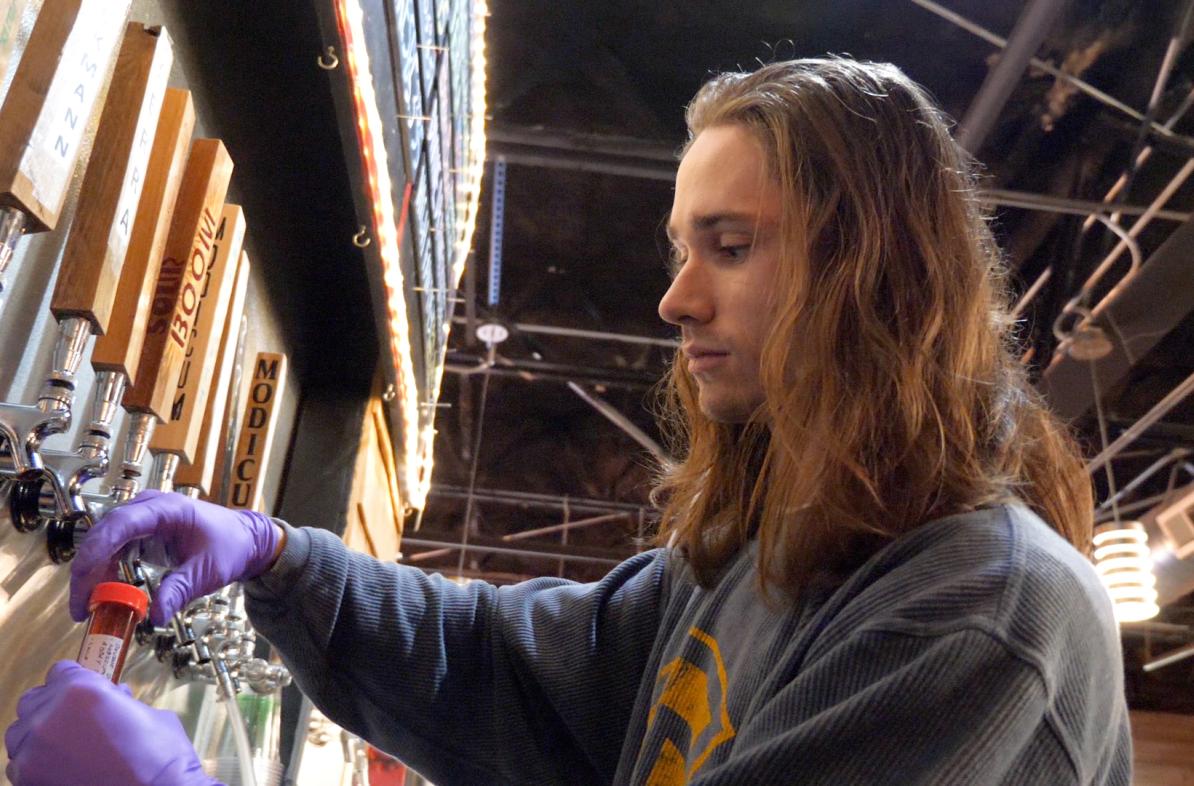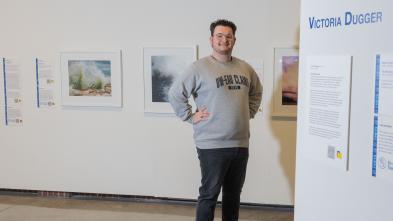
Blugolds tap into the chemistry of brewing
For Lucille Smith, a senior biochemistry/molecular biology major at the University of Wisconsin-Eau Claire, a unique chemistry research project in the community has strangely turned out to be both surprising and oddly familiar.
Smith’s fall-semester chemistry lab course with Dr. Scott Bailey-Hartsel, professor of chemistry and biochemistry, conducted color analysis research at Modicum Brewery in Altoona, analysis that allowed students to apply their chemistry knowledge and lab skills to helping an area small business achieve quality control through the use of technology available to the university.
“Well, I was very surprised to discover that our class would be conducting research about beer,” Smith says. “I had no idea the depth of science and applied chemistry that goes into an industry like beer.”
While the St. Paul, Minnesota, native found the high level of science behind the making of beer to be surprising, she says she found the basic process to be familiar because her father was a home brewer.
“We toured a lot of breweries and wineries when I was young, so being here brought back memories of helping my dad with his brews, adding the hops and connecting the hoses,” Smith says. “It was fun.”

Smith’s CHEM 453 course with Bailey-Hartsel conducted research, in part, to help a Georgia-based technology company test a new instrument, an advanced piece of spectrophotometry equipment capable of better testing beer color.
“A company called Olis Instruments in Athens, Georgia, reached out because I’ve done previous research in the beer industry,” Bailey-Hartsel says. “They actually donated the new instrument, worth $10,000, so our lab could test it, use it and offer them feedback.”
As new December chemistry graduate Erik Marcotte explains, the instrument can take beer color testing further than previous spectrophotometers.

Students collected samples of six different beers in a range of brew colors and ran parallel studies using two distinct testing methods to quantify color.
“We tested six different beers with both the old methods and also with this new machine, comparing the results,” the Brooklyn Park, Minnesota, native says. “The new machine can quantify color through hazy beers, something the standard spectrophotometry cannot do. This should make a big difference in the industry where there are so many IPAs and other beers with haziness.”
Marcotte, who worked at a microbrewery in the Twin Cities during his summer breaks, says he’s grateful for the course-embedded research project in this class, his first opportunity to take part in collaborative research.
“As a member of the Blugold swim and dive team, I’ve never had the extra time to pursue research as an intern or research assistant, so this has been a great opportunity in a topic that really interests me,” Marcotte says.
The growing community role of Blugold chemistry
The recurring course-embedded brewery industry research in Bailey-Hartsel’s courses are part of a concerted department effort to expand the community reach of student research into applied chemistry, an effort that is likely to continue to bring more opportunities for UW-Eau Claire chemistry and biochemistry students to explore potential career fields in applied chemistry.
Dr. Deidra Gerlach, assistant professor of chemistry and biochemistry, is the faculty lead for the chemistry with a business emphasis degree at UW-Eau Claire. She is excited to see the growth of interest among industries near and far who seek university help in finding solutions to their various production or quality-control concerns.
“Each semester our department receives multiple communications about collaborations,” Gerlach says. “Some questions are a matter of clarification or information sharing, but from time to time, they are requests for measurements or experiments from local industry.”
Gerlach cites the following types of recent inquiries:
- A local chemical distributor had an inquiry from one of its buyers who was concerned that the distributor received a chemical that was mislabeled. The distributor asked UW-Eau Claire to determine how to measure the difference between the actual and claimed identity.
- A local computer company needed assistance in developing a definitive and cost-effective analysis of its cooling system’s circulation to verify that all coolant had been removed. The company funded students to search for a solution under the direction of Dr. Krysti Knoche Gupta, assistant professor of chemistry and biochemistry, in the upper-level modern applied separations and spectroscopy course.
- A small company in Illinois heard from an alumnus that UW-Eau Claire chemistry does exceptional research. This company wanted to quantify the efficacy of its product for removing carcinogens from human skin for firefighter hygiene; the company funded a research project between Cambridge Sensors and two research students under the direction of Dr. James Boulter, professor of chemistry and biochemistry.
Gerlach says the consistency of inquiries resulting in high-impact student projects has prompted her to pull chemistry and biochemistry students into the inquiry evaluation process, creating another unique student experience.
“I’ve established the Chemistry Student Consulting Group,” Gerlach says. “The UW-Eau Claire Office of Research and Sponsored Programs has granted seed funds for students to create a prospectus for regional small chemical businesses who lack the expertise or instrumentation to solve minor problems or who may be interested in sponsoring scholarly interests at UWEC.”
The students will then assess each inquiry, determine a scope, timeline and budget for the project, and coordinate the execution of data analysis and reporting. Gerlach says that some inquiries can be one-off measurements, classroom projects or independent research projects, while others could be ongoing.
“The role of this Chemistry Student Consulting Group is to provide an alternative high-impact practice for students who have a diverse set of skills among chemistry and business,” she says.
While this consulting group is rooted in the chemistry and business program, Gerlach says the best news is that students in any of the chemistry and biochemistry majors or minors stand to benefit from the resulting influx of community and industry outreach collaborations.
You may also like


